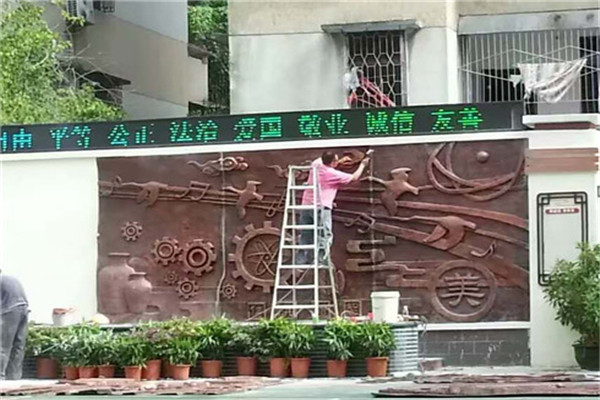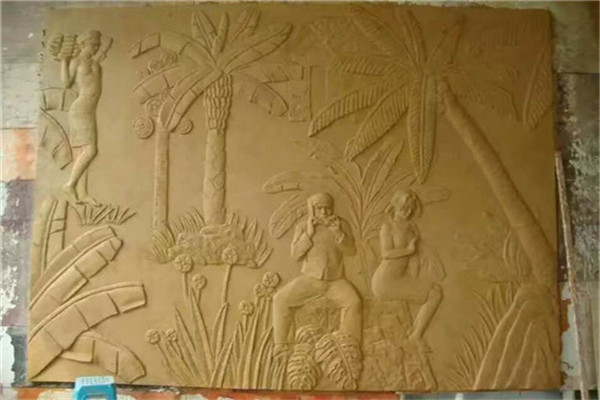
The art of carving various patterns and images on stones, usually also refers to sculpture handicrafts carved from stones. Chinese stone carving can be divided into bluestone carving, marble carving, white marble carving, talc carving, black crystal carving, colored stone carving, pebble carving, etc. Hui'an, Fujian, is famous for its bluestone carvings for architectural decoration and stone lions, among which the mouth of the stone lion contains stone beads that roll freely, and is famous in Southeast Asia. The marble carving in Yunnan is made from the marble of Diancang Mountain. Its patterns are like colored mountains and rivers, or dangerous peaks and valleys, or waterfalls follow the clouds. The inlaid furniture is unique. White marble carvings in Quyang, Hebei, Fangshan, Beijing and other places were mainly used for palace architectural decoration in the Ming and Qing dynasties, such as Huabiao, stone lions, railings, etc; Modern times are used for decoration of public and memorial buildings, such as the Great Hall of the People, the Monument to the People's Heroes, Chairman Mao's Memorial Hall, etc. Talc carvings in Haicheng, Liaoning Province and Laizhou, Shandong Province use small and cute animals as traditional varieties. The carvings of black crystal stone in Dongkou, Hunan and Lichuan, Hubei are dark and bright. Caishi carving is mainly produced in Qingtian, Zhejiang, Shoushan, Fuzhou, and Liuyang, Hunan. Pebble carvings are mainly produced in Lanzhou, Shenyang and other places. Stone carving techniques include intaglio (contour carving), shadow carving, relief, round carving (complete three-dimensional carving without any background), and openwork (also known as openwork). Shadow carving is a unique technique of Fujian Hui'an bluestone carving. It uses steel drills of different sizes to chisel on the bluestone, and uses the size, depth and density of the drill points to express the images of landscapes, birds, animals, people, flowers, etc.

The dough figurines are commonly known as dough figurines, gift buns, flower cakes and dough figurines. It uses glutinous rice flour as the main material, mixed into different colors, and shapes various vivid images with hands and simple tools. In the old society, the dough figuring artists "just make a living and walk around in tears", carrying suitcases, walking around villages and towns, and working in the streets, are deeply loved by the masses. However, their works are regarded as a gadget and cannot be put on the stage of elegance. Today, dough sculpture art is valued as a precious intangible cultural heritage, and gadgets have also entered the art palace. The dough kneader takes materials at will according to his needs. After several times of kneading, rubbing, rubbing, and lifting, he uses a small bamboo knife to skillfully place, cut, carve, scratch, shape his body, hands, and head, and put on hair ornaments and clothes. In a moment, the vivid artistic image will be released.

Marble, granite, Hui'an stone, Qingtian stone, Shoushan stone, Guicui stone and other materials are generally used for stone carving. Granite and marble are suitable for carving large statues; Qingtian stone and Shoushan stone are rich in color, which are more suitable for small stone carvings. There are many ways to make stone carvings. According to the nature of stone materials and the habits of the carvers, stone carvings can be roughly divided into two types: first, traditional methods. Conception, composition, modeling and stone carving are all done by individuals alone. For large-scale carving of lines, the horizontal and vertical lines shall be drawn on the stone, the grid shall be made to take materials, and the simple measurement and positioning method shall be used for carving. The second is to adopt a new process, that is, first make a clay sculpture, turn it into a plaster statue, then take the plaster statue (model) as the basis, rely on the point shaped instrument, and then carve it into a stone statue.

Microcarvings pay special attention to the selection of materials. The stone material should be absolutely pure, and there should be no sand grid or half silk cracks, because half a sand dot may damage a fine picture or more than 10 Chinese characters. Secondly, the micro carving knife is also a special thin knife, which should be sharp and sharp. It is necessary to have a particularly proficient knowledge of calligraphy and traditional Chinese painting. When carving, "meaning carving" and "meaning carving" can be carried out. Hold your breath and concentrate on your thoughts on the spot. The knife should be stable, accurate and ruthless. The micro carved knife is just a pen. The skill is not enough. Because the knife is slightly out of control, it doesn't reach its purpose. The calligraphy effect must be paid attention to when matching the micro engraving inscriptions on the micro sculpture works. The creators should avoid the ugly appearance, the skew of characters, the uneven lines, the inaccuracy of paintings, and the imbalance of matching. We should grasp the artistic effect of the line changes produced by cutting tools and customized stones. Only in this way can calligraphy and knife techniques and strokes be perfectly unified.

Sculpture art is a kind of plastic arts, also called sculpture, which is the general name of three creation methods of sculpture, carving and sculpture. It refers to the art of using various plastic materials (such as gypsum, resin, clay, etc.) or hard materials (such as wood, stone, metal, jade, agate, etc.) that can be carved or carved to create a visual and touchable artistic image with a certain space to reflect social life and express artists' aesthetic feelings, emotions, and ideals. Ding'an GRC component processing It is diverse, so the law of development has different ups and downs. For example, the bronze ware manufacturing and decorative carving in the Yin and Zhou Dynasties in China were unmatched by future generations. The themes of the Han Dynasty's stone reliefs fully reflect the real life at that time. cost performance GRC component processing The sculptures in the Tang and Song dynasties certainly exceeded those in the Han Dynasty, but the works of the Tang and Song dynasties never fully reflected the reality as the Han Dynasty stone reliefs did. The handicraft industry and commerce in the Ming Dynasty were improved compared with those in the Tang and Song Dynasties, but few sculptures in the Ming Dynasty fully displayed the characteristics of each work as in the Song Dynasty. Although the sculpture of the Ming Dynasty is not as good as that of the Tang and Song Dynasties, other artistic achievements of the previous dynasties are naturally behind.





